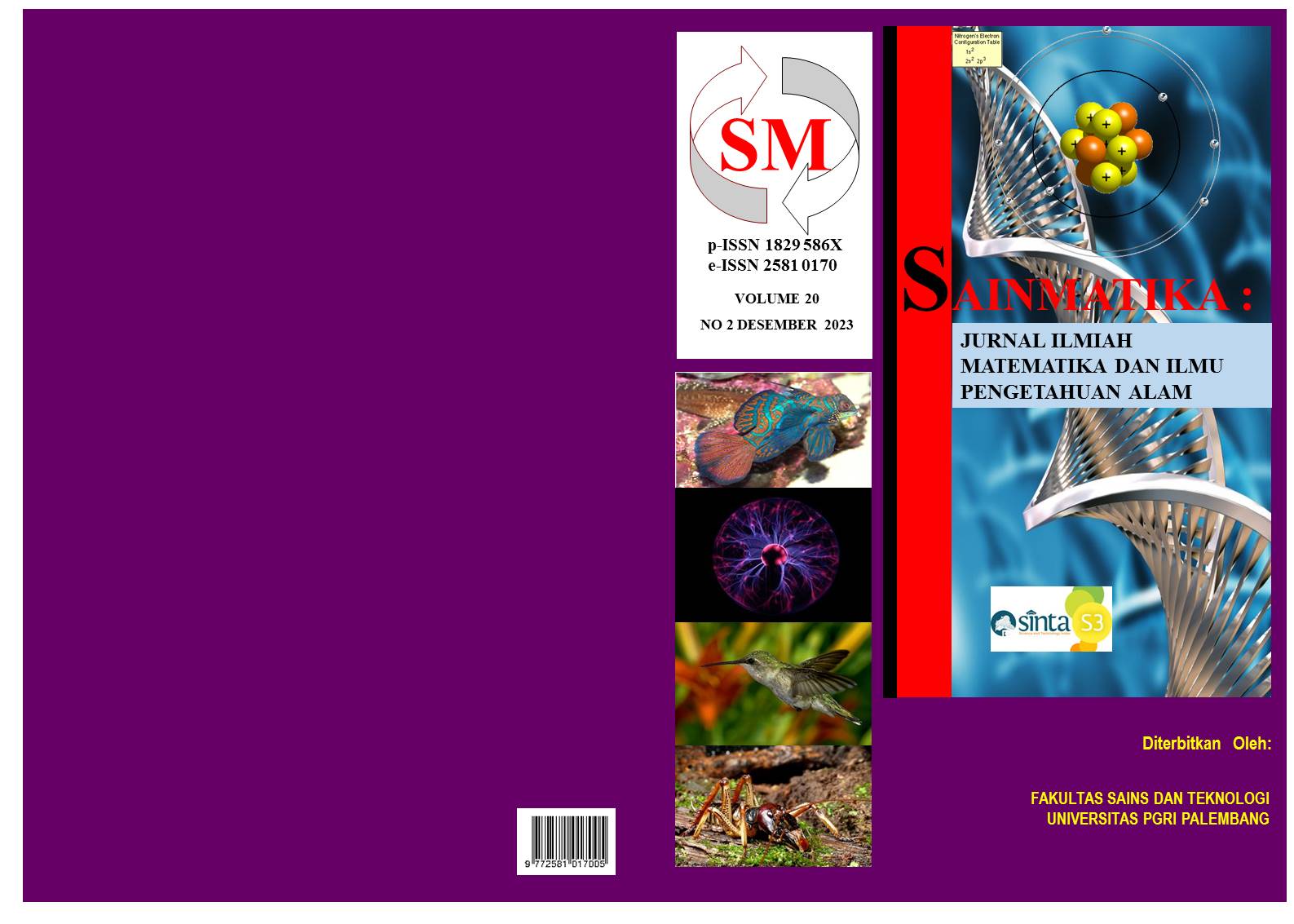Topography Effects on Rainfall Characteristics in Bandung City and Cilacap Regency for the 2016-2020 Period
DOI:
https://doi.org/10.31851/sainmatika.v20i2.11898Keywords:
rainfall, regression, time series, topographyAbstract
Topography and rainfall correlate with each other. Therefore, this study aims to determine the effect of topography on rainfall characteristicss in the Cilacap and Bandung areas. The research method used is a descriptive statistical analysis of average monthly, seasonal, and annual rainfall. In addition, time series and regression tests were carried out using the SPSS application. The data used is the daily rainfall data period of 2016–2020. The results of the descriptive analysis show that the variability of monthly rainfall in Bandung is higher than in Cilacap, with a value range that is 113.6–643.82 mm/month for Bandung and 92.1-355.56 mm/month for Cilacap. Global climate dynamics for instance apparent sun motion, Monsoon, ITCZ, ENSO, and IOD, as well as local weather systems like valley winds, also affect seasonal and annual rainfall variability in Bandung and Cilacap. The rainfall time series test produces values that are not stationary concerning the variance but stationary concerning the average. A simple linear regression test shows the effect of a topography of 55.2% on rainfall. The purpose of simple linear regression is to understand and model the relationship between two variables: the independent variable (topography) and the dependent variable (rainfall characteristics).
References
Ahrens, C. D. (2007). Meteorology Today: An Introduction To Weather, Climate, And The Environment (8th ed.). Belmont, USA: Thomson Brooks/Cole.
Aldrian, E., & Susanto, R. D. (2003). Identification Of Three Dominant Rainfall Regions Within Indonesia And Their Relationship To Sea Surface Temperature. International Journal Of Climatology, 23(12), 1435–1452.
Azka, M. A., Dzikiro, T. K., Simanjuntak, J. T., & Winarso, P. A. (2018). Kajian Kondisi Atmosfer Terkait Banjir Di Kabupaten Cilacap Pada Tanggal 7 Oktober 2017. Seminar Nasional Fisika Dan Aplikasinya, 173–183.
Bayong Tjasyono H. K. (2004). Klimatologi. Bandung: Penerbit ITB.
Hermawan, E. (2010). Pengelompokkan Pola Curah Hujan Yang Terjadi Di Beberapa Kawasan Pulau Sumatera Berbasis Hasil Analisis Teknik Spektral. Jurnal Meteorologi Dan Geofisika, 11(2), 75–85. https://doi.org/10.31172/Jmg.V11i2.67
Hidayati, R., Ramalis, T. R., & Mujtahiddin, M. I. (2015). Analisis Kejadian Hujan Es di Wilayah Bandung Berdasarkan Kondisi Atmosfer Dan Citra Satelit Analysis Of Hailstone At Territorial Bandung Bases Atmospheric Condition And Satellite Image. Jurnal Fibusi, 3(1), 1–9.
Nabilah, F., Prasetyo, Y., & Sukmono, A. (2017). Analisis Pengaruh Fenomena El Ninodan La Ninaterhadap Curah Hujan Tahun 1998-2016 Menggunakan Indikator Oni (Oceanic Nino Index) (Studi Kasus: Provinsi Jawa Barat). Jurnal Geodesi Undip, 6(4), 402–412.
Nurafifah, U. O., Zainuri, M., & Wirasatriya, A. (2022). Pengaruh ENSO Dan IOD Terhadap Distribusi Suhu Permukaan Laut Dan Klorofil-A Pada Periode Upwelling Di Laut Banda. Indonesia Journal Of Oceanography (IJOCE), 4(3), 74–85.
Prasetyo, S., Kurniawan, W., & Rumahorbo, I. R. (2021). Synoptic And Mesoscale Analysis Of Extreme Rainfall Event In Cilacap Meteorological Station, Indonesia On December 7, 2018. In Jurnal Ilmu Dan Inovasi Fisika), 05(02).
Prasetyo, B., Irwandi, H., & Pusparini, N. (2018). Karakteristik Curah Hujan Berdasarkan Ragam Topografi Di Sumatera Utara. Jurnal Sains & Teknologi Modifikasi Cuaca, 19(1), 11–20.
Primayuda, A. (2006). Pemetaan Daerah Rawan dan Resiko Banjir Menggunakan Sistem Informasi Geografis. Bogor: Institut Pertanian Bogor.
Rahayu, N. D., Sasmito, B., & Bashit, N. (2018). Analisis Pengaruh Fenomena Indian Ocean Dipole (Iod) Terhadap Curah Hujan Di Pulau Jawa. Jurnal Geodesi Undip, 7(1), 57–67.
Safitri, S. (2015). El Nino, La Nina Dan Dampaknya Terhadap Kehidupan Di Indonesia. Jurnal Criksetra, 4(8), 153–156.
Satiadi, D., & Fathrio, I. (2011). Penentuan Onset Monsun Di Wilayah Indo-Australia Berdasarkan Lompatan Itcz. Jurnal Sains Dirgantara, 9(1), 1–11.
Supriyati, Tjahjono, B., & Effendy, S. (2018). Analisis Pola Hujan Untuk Mitigasi Aliran Lahar Hujan Gunungapi Sinabung. J. Il. Tan. Lingk, 20(2), 95–100. https://doi.org/https://doi.org/10.29244/jitl.20.2.95-100
Syahbuddin, H., Manabu, D., Yamanaka, & Runtunuwu, E. (2004). Impact Of Climate Change To Dry Land Water Budget In Indonesia: Observation During 1980-2002 And Simulation For 2010-2039. Kobe: Kobe University Press.
Tjasyono, B. (1999). Klimatologi Umum. Bandung: Institut Teknologi Bandung.
Tjasyono K, B. H., & Harijono, S. B. (2008). Pengaruh El Niño, La Niña Dan Indian Ocean Dipole Terhadap Curah Hujan Pentad Di Wilayah Indonesia (Ina J. Dkk.) Pengaruh El Niño, La Niña Dan Indian Ocean Dipole Terhadap Curah Hujan Pentad Di Wilayah Indonesia. Jurnal Bionatuna, 10(2), 169–177.
Triatmodjo, B. (2008). Hidrologi Terapan. Yogyakarta: Beta Offset.
Triyanti, R., Wijaya, R. A., Koeshendrajana, S., & Priyatna, F. N. (2010). Karakteristik Dan Nilai Manfaat Langsung Sumber Daya Pesisir (Studi Kasus Di Perairan Segara Anakan, Kabupaten Cilacap). Jurnal Bijak Dan Riset Sosek KP, 5(1), 31–46.
Tukidi. (2010). Karakter Curah Hujan Di Indonesia. Jurnal Geografi, 7(2), 136–145.
Wahid, M. A., & Phi, J. (2018). Mengidentifikasi Besar Kecepatan Angin dan Energinya Melalui Data Ncep/Ncar Reanalysisdan 5 Stasiun Bmkg di Provinsi Aceh. Jurnal Pendidikan Fisika Dan Fisika Terapan, (1), 1–10.
Webster, P. J. (1987). The Variable and Interactive Monsoon (J. S. Fein & P. L, eds.). New York: John Wiley.

Downloads
Published
Issue
Section
License

This work is licensed under a Creative Commons Attribution-NonCommercial-ShareAlike 4.0 International License.








